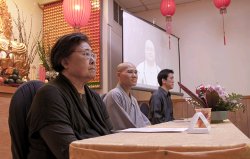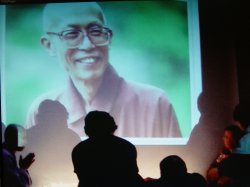The Commemorative Ceremony for Master Sheng Yen: In Loving Memory of Our Teacher
On Sunday, February 21, 2010, CMC held a commemorative ceremony for Master Sheng Yen. The day started with greetings and blessings from Abbot President Guo Dong via Internet.

In his address, Abbot President said that Shifu never considered himself the leader of DDM, but rather used the principles of DDM to lead the community. DDM’s mission is to emphasize spiritual environmentalism as its central focus, promote Chinese Buddhism, and establish a pure land on earth.
Shifu stressed the necessity to establish consensus to determine the goal, mission, direction, method and principles for leading DDM which requires resources from within and outside DDM.
In the 2010 theme, "Peace, Harmony and Abundance," "peace" refers to peace within oneself, and bringing peace and joy to all sentient beings. “Harmony” refers to harmonious interactions with others and harmony within oneself. When we have peace and harmony, we can have a life of fulfillment—this fulfillment is what is meant by "abundance."
Shifus’ last wishes were that we be grateful for having virtuous roots, the ability to study and practice the dharma, to have a community of practitioners, and be able to receive the guidance and teachings of all buddhas and bodhisattvas in all realms. We should make use of the past to create the future and have the great compassionate vow to put these teachings into practice.
Abbot President concluded the talk with blessings of peace, harmony, health and joy. The talk was followed by a panel sharing by the Abbot of CMC and DDRC, Venerable Guo Xing, Professor Chun-fang Yu, Chair of the Master Sheng Yen Professorship at Columbia University, and Professor Jimmy Yu (Guo Gu), Assistant Professor at Florida State University at Tallahassee.

Professor Jimmy Yu said that the purpose of this gathering was to remember Shifu, but more importantly, to remember his teachings, and that when we make use of the teachings, he will be with us.
This, he said, is the best way to repay our gratitude to Shifu. Jimmy met Shifu as a teenager and later became his monastic attendant. For Jimmy, there were benefits and drawbacks to being so close to Shifu; the benefits were that he could ask questions often and the drawback was that Buddhism must be experienced by oneself through the process of encountering difficulties.
These difficulties are the facing of our own obstacles, self-referentiality or karmic baggage. If a difficulty is easily pacified, it may deflate the momentum of practice. Jimmy remembered one particular summer when Shifu left him and went to Taiwan. He read a letter written by Shifu on January 29, 1980 and published in Chan Newsletter, Number 3:
(To read the letter in its entirety, go to http://www.chan1.org/ddp/channews/02-1980.html#shifu-parting )
Professor Chun-fang Yu shared stories about her first meeting with Shifu in spring of 1976 at the Temple of Enlightenment while teaching at Rutgers University. At that time, Shifu had just completed his PhD in Japan and was invited to the Abbot at the temple. Professor Yu and her students went to the temple as part of a field study, because she felt it was not enough to study Buddhism from books but to practice and experience it as a living religion, not simply as a philosophy or a system of ethics.

Shifu did not introduce himself as the Abbot, nor as a scholar or great Chan master. Shifu was determined to spread Buddhadharma to Westerners and decided that the most effective way to do so is through Chan meditation. Professor talked about these first meditation classes and her own struggles with meditation.
Professor Yu said that Shifu always insisted, “Put everything down. Forget about the past, forget about the future; only the present is real.” These words helped her through life, carrying her through good times and bad. “Putting things down and getting rid of baggage from one’s personal life is such a relief.
Even if there are many happy things in your life, if you carry it, if you dwell on it, it does you no good, because the past is gone and will never come back. There is no sense of anticipating or hoping for the future, because the future is not here. Only the present moment is important, and that we can control.”
Venerable Guo Xing shared stories about Master Sheng Yen’s dedication in promoting Chan Buddhism. Shifu had noticed that Theravadan and Tibetan Buddhism were known all over the world but Chinese Buddhism had a very limited presence.
Although Chinese Buddhism has a two thousand year old history, with a thousand years of sutra translation and a thousand years of Chan masters, its cultural and spiritual wealth was difficult to see in the world. Shifu said that this is because there is a lack of talented people with faith in Chinese Buddhism and expressed the need for people with doctorates in Chinese Buddhism.
In 2006, Shifu described the current situation of Chinese Buddhism to his monastic disciples:
1. The number of practitioners propagating Chinese Buddhism is decreasing.
2. There are very few practitioners who can spread Chinese Buddhism, are knowledgeable of its doctrines, have a deep level of personal experience, and understand the path and development of the various doctrines and stages of practice.
3. There are very few people who have experiences in Chinese Buddhism, are in touch with modern-day life and can respond to the needs of contemporary people.
4. There are many people who practice Chinese Buddhism as well as other forms of Buddhism.
Ven. Guo Xing predicted that Westerners will adapt and combine the different traditions of Buddhism and its methods to fulfill their own needs and create a new type of Buddhism. This can already be seen in the use of “mindfulness techniques” in hospitals and the popularity of meditation, Tai Chi, yoga, and other meditative exercises to relieve stress and manage health.
Shifu had said that though Chinese Buddhism has eight different schools, the nature of all eight schools is Chan, and only Chan can be accepted by Westerners, and emphasized the bodhisattva path is the best practice. Shifu’s attitude in promoting Chinese Buddhism was to follow the causes and conditions—if there is an opportunity, he will use the opportunity to promote.
If there are any obstacles, he will overcome the obstacles. If other strengths can be learned, he will learn them; if they are unsuitable, he will give up. But his goal to promote Chinese Buddhism never changed.
Shifu never rested when training a new student; training not only high-level researchers in Chinese Buddhism but beginner Chan meditators, eventually establishing a Chan Buddhist university and universalizing Chan teachings so that a broader audience would be able to learn Chan. Shifu’s last words were: “The various tasks that I was not able to finish in this lifetime, I hope that everyone will be able to help to accomplish.”
After lunch, a short film entitled “Master Sheng Yen: A Chan Mind at Ease” was shown. Afterwards, Dharma Teachers in Training shared what they learned from Shifu and how they apply the teachings in their lives. Later, the audience formed small groups for discussions on what they learned from Shifu and from their participation at CMC. To close, there was a Vow and Lamp Lighting Ceremony, where participants were encouraged to make vows, take action and to share their practice.
A group vow, led by Ven. Guo Xing, was made through a reading of “The Practices of a Bodhisattva” written by Master Sheng Yen:
How do we complete the path to Buddhahood?
We must initiate our bodhi mind.
What is the bodhi mind?
Benefiting others above all.
For the sake of benefiting sentient beings,
We do not fear suffering and difficulties.
If others depart from suffering,
Our own suffering would be assuaged.
Those who aspire to learn from the Buddha,
Are proclaimed bodhisattvas.
The supreme act of a bodhisattva
Is to deliver sentient beings with wisdom and compassion.
Participants were invited to make individual vows and offer lamps as symbols of offerings to Shifu. Chang Wen Fashi instructed, “As you hold this lamp, visualize that your vow is contained within the light of this lamp. This light represents the light of wisdom and compassion, which, through our actions, we embody.” The day concluded with distribution of gifts to participants.
(Report by Chang Jie)
